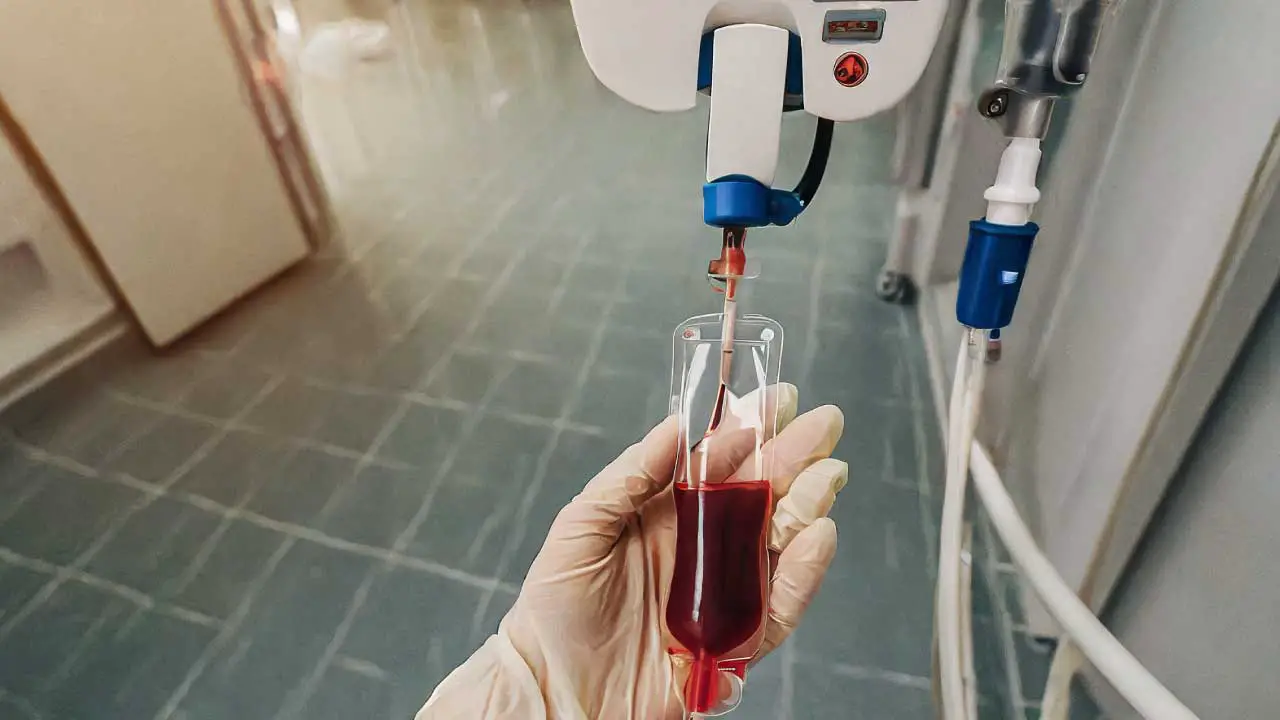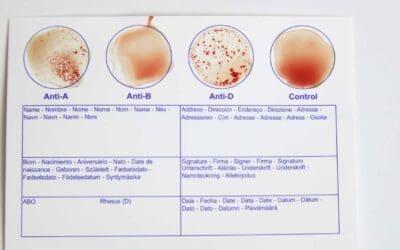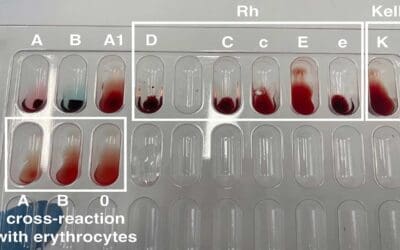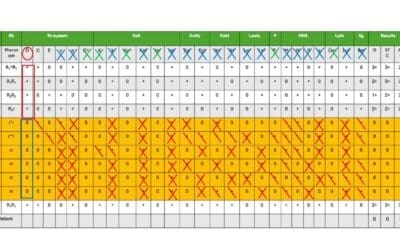TL;DR
Definition ▾
Acute hemolytic transfusion reaction is an acute hemolysis due to the administration of antigenically incompatible red cells.
Timing ▾
During transfusion or within 24 hours.
Signs and Symptoms ▾
- Fever: Often the first sign, occurring within minutes or hours of the transfusion.
- Chills
- Back pain
- Chest pain or tightness
- Shortness of breath
- Nausea and vomiting
- Hemoglobinuria
- Hypotension
- Tachycardia
- Flushing
- Dyspnea
- Headache
- Agitation
In severe cases, acute hemolytic transfusion reaction can lead to:
- Shock
- Disseminated intravascular coagulation (DIC)
- Renal failure
Causes or mechanism ▾
- Usually due to clerical error causing ABO incompatibility.
- Presence of preformed antibodies in the body against transfused blood causing intravascular hemolysis.
- IgM or complement-fixing IgG e.g. anti-A or anti-B.
Treatment and management ▾
- STOP infusion
- Identity of patient and unit must be reconfirmed
- Serologic testing repeated on donor blood and post-transfusion samples of patient’s blood:
- Repeat grouping on pre- and post-transfusion samples and donor blood
- Repeat crossmatch
- Perform DAT on post-transfusion sample
- Check plasma for hemoglobinemia
- Perform DIC tests
- Examine donor sample for gross bacterial contamination
- Maintain IV access
- Monitor blood pressure and urine output
*Click ▾ for more information
What is an acute hemolytic transfusion reaction?
An acute hemolytic transfusion reaction is a severe adverse reaction that occurs during or within 24 hours of a blood transfusion. It is caused by the destruction of red blood cells in the recipient’s blood by antibodies in the donor blood. Acute hemolytic transfusion reaction can be fatal.
What are the symptoms of acute hemolytic transfusion reaction?
Acute hemolytic transfusion reaction symptoms can vary depending on the severity of the reaction. Mild acute hemolytic transfusion reactions may cause only a few symptoms, such as fever and chills. Severe acute hemolytic transfusion reactions can cause a variety of symptoms, including:
- Fever
- Chills
- Hives
- Itching
- Shortness of breath
- Chest pain
- Nausea and vomiting
- Low blood pressure
- Back pain
- Hemoglobinuria (red urine)
- Jaundice (yellowing of the skin and eyes)
- Shock
The clinical features of acute haemolytic transfusion reactions can be divided into 3 phases.
- The initial phase is the hemolytic shock phase: Patients generally develop fever and chills, often accompanied by dyspnoea, tachycardia, hemoglobinuria and severe pain, usually in the lower back. Transfusion of a large volume of ABO-incompatible blood often produces hypotensive shock, oliguria and disseminated intravascular coagulation.
- In the oliguric phase: Some patients may experience renal tubular necrosis with acute renal failure
- Diuretic phase: Fluid and electrolyte imbalance may occur during the recovery from acute renal failure.
How long does it take for acute hemolytic transfusion reactions to occur after transfusion?
Acute hemolytic transfusion reaction can occur at any time during or within 24 hours of a blood transfusion. However, they are most likely to occur within the first few hours of the transfusion.
What causes acute hemolytic transfusion reactions?
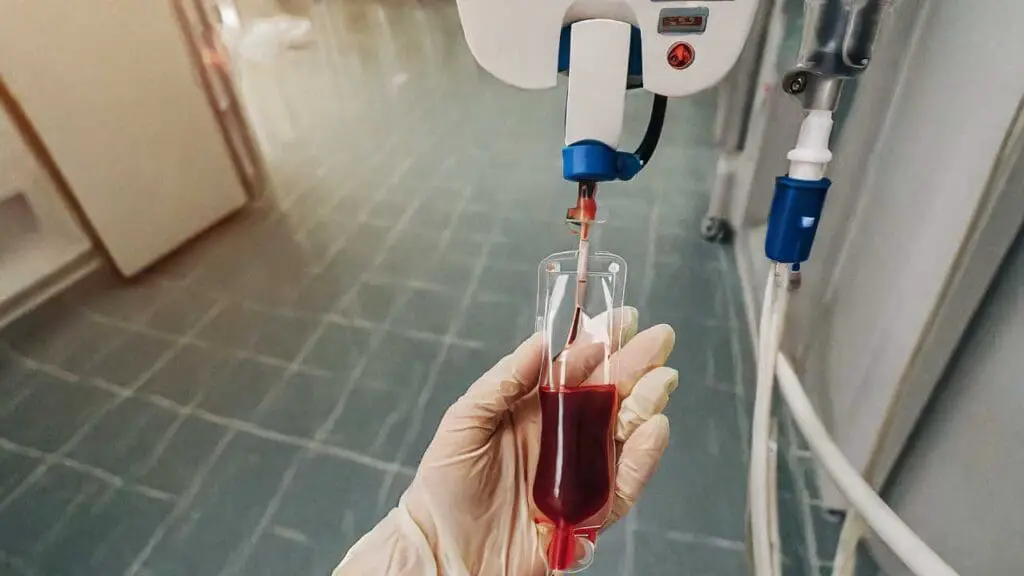
Acute hemolytic transfusion reactions are caused by the destruction of red blood cells in the recipient’s blood by antibodies in the donor blood. These antibodies can be either ABO antibodies or non-ABO antibodies.
ABO antibodies are the most common type of antibody involved in acute hemolytic transfusion reactions. ABO antibodies are naturally occurring antibodies that are present in the blood of most people. These antibodies target specific antigens on the surface of red blood cells. There are four ABO blood groups: A, B, AB, and O. People with blood group A have antibodies to blood group B, people with blood group B have antibodies to blood group A, people with blood group AB have no ABO antibodies, and people with blood group O have antibodies to both blood group A and blood group B. The mechanism involved is preformed antibodies in the body for example if an individual with type B blood received a unit of type A blood by mistake, the recipient’s preexisting anti-A antibodies will cause complement fixation and intravascular lysis of the transfused cells. The patient’s clinical presentation depends on how much blood was infused before the error was suspected and the transfusion stopped.
Non-ABO antibodies are antibodies that are not naturally occurring. They can be developed in response to a previous blood transfusion, pregnancy, or certain medical conditions. Non-ABO antibodies can target a variety of antigens on the surface of red blood cells.
When incompatible ABO or non-ABO antibodies in the donor blood react with red blood cells in the recipient’s blood, the red blood cells are destroyed. This process is called hemolysis. Hemolysis can release hemoglobin and other harmful substances into the bloodstream. These substances can cause a variety of symptoms, including fever, chills, shortness of breath, and low blood pressure. In severe cases, hemolysis can lead to shock and death.
How is acute hemolytic transfusion reaction (AHTR) treated and managed?
The treatment for acute hemolytic transfusion reaction depends on the severity of the reaction. The principal object of initial therapy is to maintain the blood pressure and renal perfusion. During this time, it is critical to maintain IV access and to carefully monitor blood pressure and urine output. Mild acute hemolytic transfusion reactions may require only supportive care, such as fluids and oxygen. Severe acute hemolytic transfusion reactions may require more aggressive treatment, such as:
- Intravenous fluids: Intravenous fluids can be used to maintain blood pressure and to prevent dehydration.
- Blood transfusions: Blood transfusions may be used to replace the red blood cells that have been destroyed.
- Diuretics: Diuretics can be used to increase urine output and to help remove hemoglobin from the bloodstream.
- Alkaline diuresis: Alkaline diuresis is a treatment that involves giving the patient intravenous fluids and sodium bicarbonate to increase urine output and to help remove hemoglobin from the bloodstream.
- Corticosteroids: Corticosteroids can be used to reduce inflammation.
- Mechanical ventilation: Mechanical ventilation may be required for patients with severe respiratory distress.
- Dialysis: Dialysis may be required for patients with severe kidney failure.
Most severe reactions occur because of clerical errors in the handling of donor or recipient blood specimens.
If a patient develops features suggesting a severe transfusion reaction, the transfusion should be stopped immediately and investigations for blood groups incompatibility and bacterial contamination of the blood must be initiated.
- First it must be established that the identity of the recipient is the same as that on the compatibility label and that this corresponds with the actual unit being transfused.
- Then the unit of donor blood and post-transfusion samples of the patient’s blood should be sent to the laboratory who will repeat the grouping on pre- and post-transfusion samples and on the donor blood and the crossmatch is repeated.
- DAT is performed on the post-transfusion sample and the plasma is checked for hemoglobinemia.
- DIC tests are also performed and donor sample will be examined for evidence of gross bacterial contamination and set up for blood cultures from it at 20 and 37oC.
- If the clinical picture is suggestive of bacterial infection, blood cultures must be taken from the patient and broad spectrum IV antibodies started.
Disclaimer: This article is intended for informational purposes only and is specifically targeted towards medical students. It is not intended to be a substitute for informed professional medical advice, diagnosis, or treatment. While the information presented here is derived from credible medical sources and is believed to be accurate and up-to-date, it is not guaranteed to be complete or error-free. See additional information.
References
- Dean L. Blood Groups and Red Cell Antigens [Internet]. Bethesda (MD): National Center for Biotechnology Information (US); 2005. Chapter 5, The ABO blood group.
- Yamamoto F. ABO+logy: Bioscience of the ABO Blood Groups for High School/College Students & Adults (2023).
- Goldberg S, Hoffman J. Clinical Hematology Made Ridiculously Simple, 1st Edition: An Incredibly Easy Way to Learn for Medical, Nursing, PA Students, and General Practitioners (MedMaster Medical Books). 2021.

